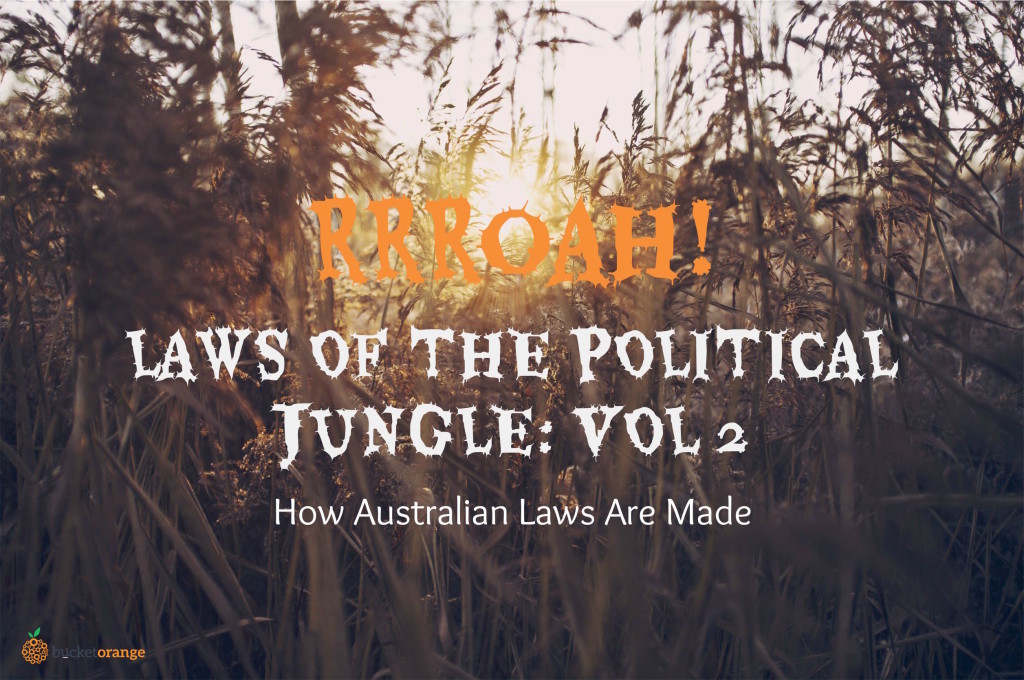
In Laws Of The Political Jungle Vol 1, we took you on a Parliamentary Safari that analogised the Marriage Equality Bill as a young zebra navigating the lions of the House of Representatives and crocodiles of the Senate in the context of:
- the role politicians play in whether a Bill is passed; and
- what rules govern whether a proposed Bill lives or dies.
In Laws Of The Political Jungle Vol 2 we continue the journey of a zebra by tracking the process involved in making a government Bill.
Laws Of The Jungle: Policy Approval
Like a young zebra surviving the threat of predators and limited resources, the process from a Bill’s inception to being made into Australian legislation is an equally dynamic journey, with many variables that impact its progress.

When it comes to making Australian legislation, you have:
- A young zebra (proposed Bill)
- Lion, crocodile and other high order predators (Ministers, MPs and Senators)
- Pride leader (Prime Minister)
- Mother Nature (The Australian Constitution)
- Elephant (Office of Parliamentary Counsel)
- Impala (Explanatory Memorandum)
- Buffalo (Second Reading Speech)
If a government Bill is to survive and become part of Australian law, it first needs:
(a) the policy approval of the Cabinet or the Prime Minister; and
(b) the approval of the Parliamentary Business Committee (PBC) of the Cabinet to be drafted.
There is a lot of work to be done before either of those required results are realised.
Just as many extraneous factors influence which zebra a lion separates from the herd to pursue, there are also many competing priorities for a place on the government’s legislative program. An established process ensures that matters relating to the highest government priorities are drafted before those of lower importance. This is called the bids process, which we will discuss later.
The Right Environment: Policy Settings
The right policy and political climate must exist for a government Bill to pass.
The policy setting can originate from various sources, for example:
- the government may have taken a policy to the electorate as part of its election platform;
- the Minister may personally require action to be taken;
- the Minister may be advised by their Department that a legislative amendment is needed;
- the Minister may be persuaded by a lobby group or other external sources that new legislation is required.
Whatever the source of the policy idea, the Minister will be briefed by their Department as to what is required and the various possibilities to achieve it. In close consultation with the Minister’s advisers, the Department will seek the Minister’s policy approval.
Cooperative Behaviour: Consultation Process
In the same way that the survival of a zebra depends on the cooperative interactions of a herd, there are many potential players that work together in the formulation of policy for a government Bill.

Extensive consultation with other Government Departments may be necessary prior to putting a final submission for policy approval to the Minister. For example, the relevant areas of the Department of the Prime Minister and Cabinet and the Attorney-General’s Department will inevitably be consulted.
There will also be as many briefings on relevant matters as the Minister, or his or her Office, requires. The Minister may also have discussions with the Prime Minister and other Ministers’ on a political level as to what is required. To determine what is legally possible to achieve through a Bill, formal legal advice may be required from the Australian Government Solicitor.
Survival Strategy: A Bill Must Fall Within The Power Of The Australian Constitution
If a proposed government Bill is to proceed, it must comply with the law of the land. The Australian Constitution is like Mother Nature and places limitations what type of Bills can be made as well as which Bills survive.

The power of the Commonwealth Parliament to legislate must be within the limits of the Australian Constitution (s51). This means that Parliament can only make laws on those matters allowed by the Constitution.
Social Acceptance: The Approval Process
Before a Bill can proceed, the need for legislation must be established. If the policy intention can be achieved without the need for a government Bill to be introduced into Parliament, then this will be the course of action taken.
The Attorney-General’s Department must be consulted on any proposed government Bill prior to Cabinet consideration of the policy setting.
Any measure in a proposed Bill that has significant policy implications must be approved by the Cabinet. Where matters are of minor policy significance, often it is necessary only to seek the Prime Minister’s approval. In deciding whether the policy for a Bill needs Cabinet approval, or whether the Prime Minister’s policy approval is sufficient, the Minister’s Department will seek the advice of the Department of the Prime Minister and Cabinet.
In any event, it is necessary to consult with every Commonwealth Department and external Government Agency that may be affected by the proposed policy prior to seeking the relevant policy approval.
Predator Avoidance Strategy: The Bids Process
When it comes to the bids process, a request (bid) from the Minister to the Prime Minister for approval to have a bill placed on the government’s legislation program for a sitting of the Parliament (either Autumn, Winter or Spring) must take place.

This occurs in the same way the Pride leader can determine whatever is necessary to advance the interests of the pride and the enhancement of the pride’s territory and resources.
The process required for approval of a Bill depends on the nature of the Bill. If a government Bill is one that requires Cabinet approval, the bids process can only begin once that approval has been obtained from the Cabinet. If policy approval from the Cabinet is not required, a letter from the Minister to the Prime Minister is sent, along with the bid seeking the necessary policy approval.
Bids fall into 4 categories of varying priority:
Category T: time-critical bills assessed as having a high priority for introduction and passage in the same sittings
A Category T Bill is the strongest and fastest zebra which is capable of entering dangerous territory and galloping through the lions of the House of Representatives and crocodiles of the Senate in one swift manoeuvre.

Category A: Bills assessed as having a high priority for introduction in the sitting period
A Category A Bill is an important, but less agile, zebra which enters either the Senate or House of Representatives and negotiates encounters with the predators of Parliament during their sitting period.

Category B: Bills assessed as having medium priority for introduction in the sitting period; and
A Category B Bill is a zebra which prefers to remain at the centre of the herd until it is necessary to cross predator country.

Category C: Bills assessed as having lower priority for introduction in the sitting period
A Category C Bill is the older and slower which lags behind others in the herd which cross to the other side of the savannah or water hole.

The Bill approval process requires that all bids made by the Minister must request a category. Category T bids must include a statement of reasons explaining why a Bill requires that status. After consideration of the requests of all Ministers the Parliamentary Business Committee allocates Bills on the government’s legislation program and accords a drafting priority for each Bill.
Complex Social Structures: The Process of Legislative Drafting
The wise and esteemed elephants of the legislative process, the Office of Parliamentary Counsel (OPC), is the body responsible for drafting Australian legislation.

Like a group of elephant, legislative drafters collectively possess a great deal of experience, subject matter expertise and long memories spanning the volume of Commonwealth legislation.
Bills for the government are drafted according to the priority assigned by the Parliamentary Business Committee. Category T Bills are completed as the highest priority. During the drafting process, the relevant government Department liaises with OPC and the Minister’s Office, as well as any other Department whose legislation may be affected by the Bill.
To draft the Bill, OPC receives instructions from the relevant government Department. Without explicitly telling OPC how to draft the Bill, drafting instructions will explain and provide the:
- full context of the policy
- detail of what is to be achieved
- consequential amendments to other legislation that may be required as a result of changes to the current legislation
- transitional arrangements that may be necessary (if any). Transitional arrangements may need to be implemented where a policy proposal impacts either favourably or adversely on a particular group of people.
In developing the Bill, OPC forwards each draft to the Department. Consultation may also take place with other Government Departments or agencies, as needed. The Minister’s Office is also fully consulted during the drafting process.
This process continues on various drafts until OPC, the Department and the Minister are satisfied that the policy objectives have been achieved.
Once finalised, the Bill is circulated by OPC to all government Departments and agencies that they believe should be consulted about the proposed legislative changes. OPC will always consult the relevant areas of the Attorney-General’s Department and the Department of the Prime Minister and Cabinet as required.

This consultation is critical to stamp out any potential problems and to clear the Bill for introduction into the Parliament.
It is not unusual for a Bill to require additional policy authority to enable the Bill to best implement the policy intent. If the initial policy for the Bill has been considered and approved by the Cabinet, often it is not necessary for the Cabinet to reconsider the matter for additional policy approval, but it may receive that approval by the Prime Minister.
In any event, no Bill can be introduced into the Parliament as a government Bill unless it has received the necessary level of policy authority for all of the measures in the Bill.
Inter-Species Relationships: Explanatory Memorandum and Second Reading Speech
To safely navigate predator-rich terrain such as the open savannah and waterhole, no three species work together more effectively than Zebra, Impala and Wildebeest.

Zebra with excellent vision, Impala with superior hearing and Wildebeest with an expert sense of smell collaborate and alert each other to approaching danger.
The Explanatory Memorandum is presented at the same time that the Bill is introduced into Parliament.

In this setting, the Explanatory Memorandum is a lot like an Impala who enters and works cooperatively alongside zebra in the dangerous open plains of Parliament. The Explanatory Memorandum is a very important document as it explains the object and purpose of the Bill, its effect and what it is intended to achieve. It is used in statutory interpretation and may be used by a court in certain circumstances.
The Explanatory Memorandum also contains a Financial Impact Statement and Notes on Individual Clauses, outlining the purpose of each clause in the Bill and how it relates to the rest of the Bill. As part of the Explanatory Memorandum there will also be a Statement of Compatibility with Human Rights and there may be a Regulation Impact Statement.
A second reading speech is also settled and approved by the Minister.
The second reading speech bears many similarities to Wildebeest, who works jointly with Zebra and Impala and will enhance the possibility for a Bill to become part of Australian law.

The second reading speech explains the Bill’s background and key policy objectives as well as the political considerations and broad policy strategies that it seeks to achieve. It may also be considered by a court in certain circumstances.
Legislation Approval Process
The legislation approval process involves the Minister approving the text of the final Bill and the Explanatory Memorandum and its submission to the Parliamentary Business Committee for their consideration. This occurs on the Monday of the sitting week proposed for the Bill’s introduction.

It is necessary to have the approval of each Minister, whose legislation is being amended by the Bill, and their approval of the relevant portion of the Explanatory Memorandum prior to the Parliamentary Business Committee meeting. OPC must also certify to the Parliamentary Business Committee that the Bill has received all the necessary policy approval for its introduction. If not the Bill cannot be introduced until all approvals have been provided and OPC has given its certification.
After introduction of the Bill, the Explanatory Memorandum is circulated by the authority of the Minister responsible for the Bill.
Once the Bill has been approved by the PBC it will be considered by the Government party room and once approved, the Minister will give notice to the House to introduce the Bill on the next sitting day.
All of the above steps occur outside public scrutiny and the documents described are not made available for public discussion unless specific permission has been granted to the Minister by the Cabinet or the Prime Minister.
The subject matter of the Bill may be politically contentious and experience great public interest. However, it is usual for the Bill and the Explanatory Memorandum to remain confidential, thereby protecting the privacy of the deliberations of government until the Bill is introduced into the Parliament.
In Conclusion
Not unlike the laws of the jungle, the procedures for making Australian legislation are predictable and finite. Just as a zebra employs the most effective strategies to survive, for a Bill to successfully pass and be made into Australian law, the right processes must be followed each time.

In Laws Of The Political Jungle Vol 3, will cover the introduction of the Bill and what may be in store for it as it progresses through the Parliament.
Further Information
- For in-depth analysis and expert opinions on Australian legislation and case law, visit:
AGS Express Law.
NB: Materials from this article have been drawn generally from Info sheets and other publications on the Australian Parliamentary website as well as the Cabinet Handbook and Legislation Handbook. For a more detailed analysis of these issues, you can refer to Info sheets and other publications on the Australian Parliamentary website or the Department of the Prime Minister and Cabinet’s website.
 Agree? Get informed about legal change that impacts you with our newsletter. You'll automatically receive fresh content each time we publish.
Agree? Get informed about legal change that impacts you with our newsletter. You'll automatically receive fresh content each time we publish.